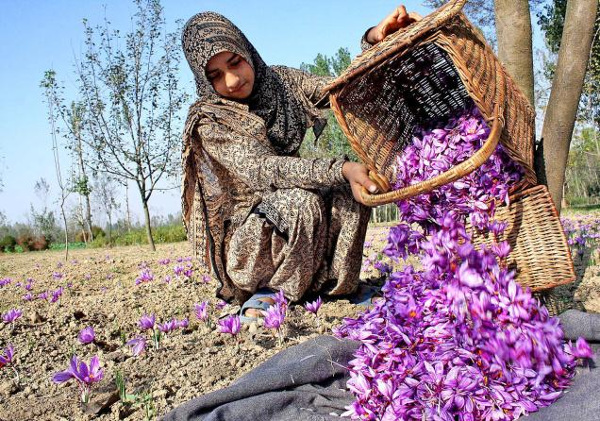New Delhi, Oct 22 (IANS) The Modi government is working on a mission mode to double the production of saffron in the Kashmir Valley, which is likely to change the fate of thousands of farmers engaged in the cultivation of this expensive spice, said agriculture scientists adding that one hectare of saffron cultivation can earn a farmer up to Rs 24-Rs 27 lakhs.
Agriculture scientist Altaf Eijaj Andrabi told IANS, “saffron is cultivated only in Jammu and Kashmir, but it has a demand all over the world. India exports saffron to England, America and some Middle East countries. It sells at Rs 5 lakh per kilogram in the international market. In India it sells at about Rs 3 lakh per kg.”
Andrabi said that right now saffron is produced 2-4.5 kg per hectare. But it can be doubled to 8-9 kg per hectare.
Saffron is also known as the golden spice and according to Andrabi, the quality of Kashmir”s saffron is the best in the world and in terms of production, it is second only to Iran.
Andrabi said that the way the Central government is focusing on the production of saffron along with the processing and training to farmers, the day is not far when saffron production will jump to double from 17 to 34 tonne, which will make it the largest producer of the coveted spice in the world leaving Iran behind.
Andrabi said that about 32,000 farmers are directly associated with saffron production in Kashmir.
Vikramaditya Pandey, a scientist at the Indian Council of Agricultural Research, PUSA, said the “national saffron mission was launched to bring about a saffron revolution in which the Indian Institute of Horticultural Research is playing a big role. The institute has adopted an integrated system to encourage and promote cultivation of saffron among farmers using drip irrigation.”
He said this new system will not only increase production, but will also require less fertiliser and water.
Saffron, which is cultivated mainly in four districts of Jammu and Kashmir — Pulwama, Budgam, Srinagar and Kishtwar — is in great demand for its medicinal, cosmetic and aromatic properties. The blossoms appear during late autumn from mid October to early November.
–IANS
Source : IANS
Image Courtesy: KashmirLife
You may also like
-
Trade Connect E-platform For Exports Is Single Window, Fast, Accessible And Transformational: Shri Piyush Goyal
-
Dot Simplifies Approval Processes For Telecom Licenses And Wireless Equipment
-
Coal Production and Supply Trends on Positive Trajectory
-
Union Minister To Release Booklets On Promotion Of Indigenous Species & Conservation Of States Fishes
-
2nd India-Japan Finance Dialogue held in Tokyo on 6th September, 2024
